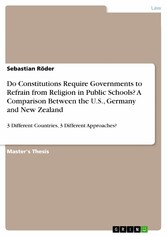Suchen und Finden
Do Constitutions Require Governments to Refrain from Religion in Public Schools? A Comparison Between the U.S., Germany and New Zealand - 3 Different Countries, 3 Different Approaches?
Mehr zum Inhalt

Do Constitutions Require Governments to Refrain from Religion in Public Schools? A Comparison Between the U.S., Germany and New Zealand - 3 Different Countries, 3 Different Approaches?
Master's Thesis from the year 2010 in the subject Law - Comparative Legal Systems, Comparative Law, grade: A-, University of Auckland, course: International Law of Human Rights, language: English, abstract: For most state activity at least accidently also affects religious groups it is quite obvious that church-state separation cannot be demanded absolutely. Accordingly the task must be to determine when a state crosses the permissible line. It is hardly surprising that this line drawing is a matter of particular delicacy in the area of public education. Religion and education both form crucial cornerstones of shaping a youth's personality. Apart from the parents it is often the state that undertakes the education of children. It is quite obvious that state neutrality and protection of religious freedom is particularly important in this area, where young children are strongly exposed to state influence. Accordingly many parents will keep a weary eye on the state's non-interference with their children's beliefs. On the other hand there are comprehensible reasons why religion may well have its place in the public educational system too. If religion plays such an important role in the self-development of adolescents does the positive freedom of religion not even dictate schools to allow students the expression of their belief in a larger community if they so wish? Moreover, it is undeniable that religions form a fundamental cornerstone of the development, identity and self-conception of almost every nation in the world. As such religion is part of a nation's history the state as well as pupils and parents may have sound reasons to honour it in a collective. It is the essay's goal to examine how different countries balance these conflicting interests in the setting of public schools. Mainly based on a comparison between the U.S. and Germany the essay will focus on two groups of cases the highest constitutional courts of both countries were confronted with. In the first body of cases the courts had to decide whether the official requirement of prayers in public schools violated the constitutions. The second group concerned the state ordered affixing of religious symbols - namely the Crucifix and the Ten Commandments - in public school classrooms. Additionally the essay contemplates a country that looks back at a relatively short tradition of a written Bill of Rights - New Zealand. Since there is only little religious freedom litigation in New Zealand the essay will confine itself to an outline of the relevant constitutional provisions followed by a prognosis as to what the outcome of a similar public school case would presumably be in New Zealand.
Alle Preise verstehen sich inklusive der gesetzlichen MwSt.






